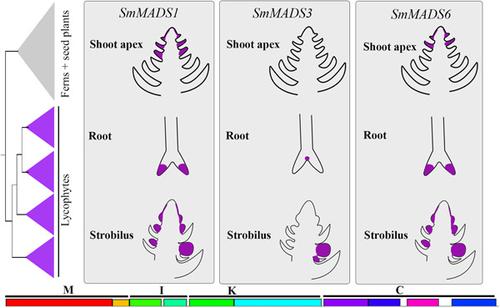当前位置:
X-MOL 学术
›
Evol. Dev.
›
论文详情
Our official English website, www.x-mol.net, welcomes your feedback! (Note: you will need to create a separate account there.)
All type II classic MADS‐box genes in the lycophyte Selaginella moellendorffii are broadly yet discretely expressed in vegetative and reproductive tissues
Evolution and Development ( IF 2.9 ) Pub Date : 2021-03-05 , DOI: 10.1111/ede.12375 Barbara A Ambrose 1 , Tynisha L Smalls 1 , Cecilia Zumajo-Cardona 1, 2
Evolution and Development ( IF 2.9 ) Pub Date : 2021-03-05 , DOI: 10.1111/ede.12375 Barbara A Ambrose 1 , Tynisha L Smalls 1 , Cecilia Zumajo-Cardona 1, 2
Affiliation

|
The MADS‐box genes constitute a large transcription factor family that appear to have evolved by duplication and diversification of function. Two types of MADS‐box genes are distinguished throughout eukaryotes, types I and II. Type II classic MADS‐box genes, also known as MIKC‐type, are key developmental regulators in flowering plants and are particularly well‐studied for their role in floral organ specification. However, very little is known about the role that these genes might play outside of the flowering plants. We investigated the evolution of type II classic MADS‐box genes across land plants by performing a maximum likelihood analysis with a particular focus on lycophytes. Here, we present the expression patterns of all three type II classic MADS‐box homologs throughout plant development in the lycophyte Selaginella moellendorffii: SmMADS1, SmMADS3, and SmMADS6. We used scanning electron microscopy and histological analyses to define stages of sporangia development in S. moellendorffii. We performed phylogenetic analyses of this gene lineage across land plants and found that lycophyte sequences appeared before the multiple duplication events that gave rise to the major MADS‐box gene lineages in seed plants. Our expression analyses by in situ hybridization show that all type II classic MADS‐box genes in S. moellendorffii have broad but distinct patterns of expression in vegetative and reproductive tissues, where SmMADS1 and SmMADS6 only differ during late sporangia development. The broad expression during S. moellendorffii development suggests that MADS‐box genes have undergone neofunctionalization and subfunctionalization after duplication events in seed plants.
中文翻译:

石松植物 Selaginella moellendorffii 中的所有 II 型经典 MADS-box 基因在营养和生殖组织中广泛但离散地表达
MADS-box 基因构成了一个庞大的转录因子家族,似乎是通过功能的复制和多样化而进化的。在真核生物中区分出两种类型的 MADS-box 基因,即 I 型和 II 型。II 型经典 MADS-box 基因,也称为 MIKC 型,是开花植物的关键发育调节因子,尤其因其在花器官规格中的作用而得到充分研究。然而,关于这些基因可能在开花植物之外发挥的作用知之甚少。我们通过进行最大似然分析,特别关注石松植物,研究了 II 型经典 MADS-box 基因在陆地植物中的进化。在这里,我们展示了石松植物整个植物发育过程中所有三种 II 型经典 MADS-box 同源物的表达模式卷柏卷柏:SmMADS1、SmMADS3和SmMADS6。我们使用扫描电子显微镜和组织学分析来确定S. moellendorffii孢子囊发育的阶段。我们在陆地植物中对该基因谱系进行了系统发育分析,发现石松植物序列出现在种子植物中产生主要 MADS-box 基因谱系的多次重复事件之前。我们通过原位杂交进行的表达分析表明,S. moellendorffii中的所有 II 型经典 MADS-box 基因在营养和生殖组织中具有广泛但不同的表达模式,其中SmMADS1和SmMADS6仅在孢子囊发育后期不同。S. moellendorffii发育过程中的广泛表达表明 MADS-box 基因在种子植物中的复制事件后经历了新功能化和亚功能化。
更新日期:2021-05-11
中文翻译:

石松植物 Selaginella moellendorffii 中的所有 II 型经典 MADS-box 基因在营养和生殖组织中广泛但离散地表达
MADS-box 基因构成了一个庞大的转录因子家族,似乎是通过功能的复制和多样化而进化的。在真核生物中区分出两种类型的 MADS-box 基因,即 I 型和 II 型。II 型经典 MADS-box 基因,也称为 MIKC 型,是开花植物的关键发育调节因子,尤其因其在花器官规格中的作用而得到充分研究。然而,关于这些基因可能在开花植物之外发挥的作用知之甚少。我们通过进行最大似然分析,特别关注石松植物,研究了 II 型经典 MADS-box 基因在陆地植物中的进化。在这里,我们展示了石松植物整个植物发育过程中所有三种 II 型经典 MADS-box 同源物的表达模式卷柏卷柏:SmMADS1、SmMADS3和SmMADS6。我们使用扫描电子显微镜和组织学分析来确定S. moellendorffii孢子囊发育的阶段。我们在陆地植物中对该基因谱系进行了系统发育分析,发现石松植物序列出现在种子植物中产生主要 MADS-box 基因谱系的多次重复事件之前。我们通过原位杂交进行的表达分析表明,S. moellendorffii中的所有 II 型经典 MADS-box 基因在营养和生殖组织中具有广泛但不同的表达模式,其中SmMADS1和SmMADS6仅在孢子囊发育后期不同。S. moellendorffii发育过程中的广泛表达表明 MADS-box 基因在种子植物中的复制事件后经历了新功能化和亚功能化。



























 京公网安备 11010802027423号
京公网安备 11010802027423号